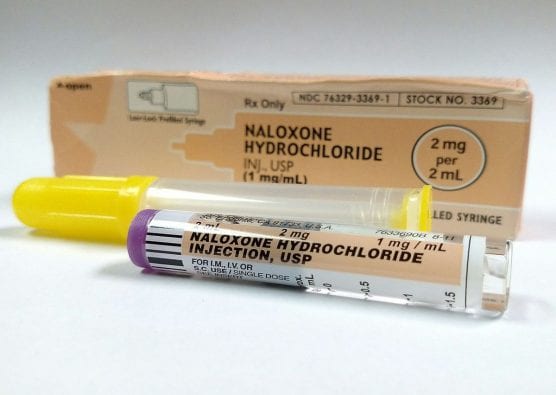By Nicholas Iovino
SACRAMENTO — California’s top public health official has issued a standing order requiring pharmacies statewide to make the life-saving, anti-overdose drug naxolone available without a prescription.
Also known by its brand name Narcan, naloxone counters the effects of an overdose by blocking opiate receptors in the brain, suppressing activity that can cause a person to stop breathing during an overdose.
California is one of 41 states that have legalized over-the-counter sales of naloxone. Gov. Jerry Brown signed legislation in 2014 that allows pharmacies to sell the overdose antidote without a prescription.
The standing order issued Thursday by California Public Health Director Dr. Karen Smith goes a step further, requiring pharmacies across the state to sell naloxone to anyone who requests it.
Generic naloxone can cost $20 to $40 per dose; Narcan costs $130 to $140 for a two-dose kit.
It was not immediately clear if insurance companies will cover the cost of non-prescription naloxone in California. The antidote comes as a nasal spray or injection kit.
The city of San Francisco, which recently launched a first-in-the-nation program to combat opioid addiction among the homeless, applauded the state’s efforts to make naloxone more widely available.
“In San Francisco we make broad use of naloxone in the community and it has saved many lives from overdose,” San Francisco Department of Public Health spokeswoman Rachael Kagan said in an email Friday. “We are supportive of measures to increase the accessibility of naloxone as a key tool to combat the opioid epidemic.”
Not everyone supports increasing access to the life-saving antidote.
Maine’s Republican Governor Paul LePaige recently vetoed legislation that would make naloxone more widely available. LePaige said it encourage drug use among those who suffer from opioid use disorder. Maine lawmakers overrode the governor’s veto in May.
In March, scholars from the University of Virginia and University of Wisconsin published a working paper that found greater access to naloxone in the Midwest led to increased opioid use, opioid-related crime, and in some places, overdose deaths.
Public health scholars have rebutted arguments against making naloxone more available to people at risk of overdosing, including a 2010 paper, “Preventing Opiate Overdose Deaths: Examining Objections to Take-Home Naloxone,” published in John Hopkins University’s Journal of Healthcare for the Poor and Underserved.
“It is unethical to allow a narrow focus on the harms of drug use to overshadow an opportunity to save human lives,” Alexander Bazazi, Nickolas Zaller, Jeannia Fu and Josiah Rich wrote in the 2010 paper.
Nearly two-thirds of the 63,632 U.S. overdose deaths in 2016 involved a prescription or illicit opioid, according to the Centers for Disease Control.
California had 1,882 opioid-related overdose deaths in 2017, a 5 percent decrease from 2015, according to preliminary data published by the state’s Department of Public Health.
An estimated 2.1 million Americans struggle with opioid use disorder, according to the U.S. surgeon general. The number of opioid overdose deaths doubled, from more than 21,000 in 2010 to more than 42,000 in 2016. The rise in overdose deaths was largely driven by an increased use of synthetic opioids such as fentanyl, according to the surgeon general and CDC.
President Donald Trump declared the opioid crisis a national health emergency in August 2017 and extended the emergency declaration this year, making $485 million available in state grants to combat the problem.
Like this:
Like Loading...
Related





 Tweet This
Tweet This Facebook
Facebook Digg This
Digg This Bookmark
Bookmark Stumble
Stumble RSS
RSS


























REAL NAMES ONLY: All posters must use their real individual or business name. This applies equally to Twitter account holders who use a nickname.
3 Comments
We have these handy but, have a shortage on EpiPens!? ?
Generic epinephrine injectors and good old fashioned ampules and syringes are still around.
I’m pretty sure that was manufactured by one of the companies the judge gave the go ahead to sue